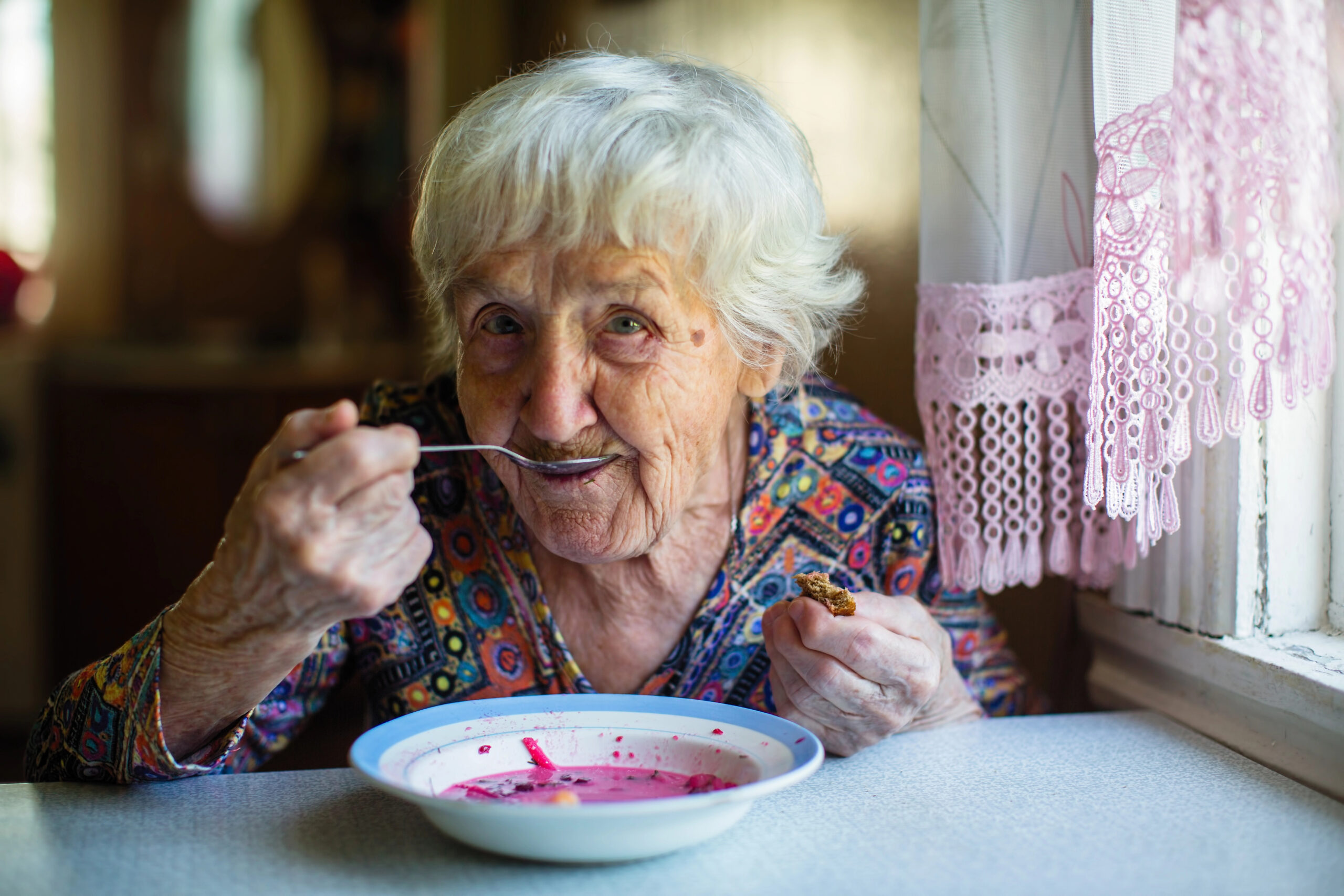A Day in the Life of a Speech-Language Pathologist with Annalisa William

Every May during Speech and Hearing Month in Canada, we raise awareness around the importance of communication health and celebrate the vital role of speech-language pathologists (SLPs) and audiologists.
At VHA Home HealthCare (VHA), our team of 13 speech-language pathologists support people of all ages with swallowing and feeding challenges as well as language and speech difficulties. During this important awareness month, we want to recognize and thank the members of our SLP team for all they do for VHA’s clients and their families.
Many people do not fully understand the extent of life-altering support SLPs provide in the home and community care sector. To help build that understanding, Annalisa William, a VHA SLP in Toronto, took us along for a typical day in the community. Annalisa shares her experiences caring for a wide range of clients, the connections she makes and the impact that she sees on a daily basis.
Annalisa William, M.S.Ed., CCC-SLP, Reg. CASLPO – VHA Rehab Solutions

Annalisa William
“When I was figuring out what to do with my life decades ago, I knew that this was my path immediately. The families I work with often say that I must really love what I do. And they are right! I am not a naturally outgoing person, but as an SLP I have to hold myself back from sharing everything about treatment plans and strategies. I am just so passionate about this work.
I also love that I am always learning new things. Not just from conferences and workshops but from my colleagues and the families I meet in the community. Helping my clients eat and drink safely, which can significantly improve their quality of life, is so rewarding. I can honestly say that being a speech-language pathologist is my dream job.”
6:30 a.m.
I leave my house, drive to my first client and arrive just after 7:30 a.m. With the extra time before my visit, I organize all my documents for the day into folders for each client and in chronological order. This includes the VHA Welcome Package for new clients, information sheets about food and liquid textures and safer swallowing strategies. I try to plan my day as efficiently as possible and am happy that my first client is an early riser like me.
8:00 a.m.
I arrive at my client’s home and hear more about the family’s concerns. Their loved one is living with Huntington’s disease and has been recently coughing when eating and drinking. Dysphagia, or difficulty swallowing, is a common symptom of Huntington’s disease. This can increase the risk of aspiration which occurs when liquid, food, or saliva ‘go down the wrong way’ and enter the airway or lung. Aspiration can lead to respiratory infections, aspiration pneumonia and other serious health issues.
I first evaluate the client’s overall oral-facial mechanisms, which includes their lips, jaw and tongue movements, cough strength and speech skills. I observe how they eat small bites of food and drink liquids prepared by the family. We use different strategies to help with swallowing including sitting as upright as possible, providing reminders to take one bite or a small sip at a time, thickening liquids and preparing the safest textures for common foods. I share my plan to monitor any changes and discuss the most effective strategies again at our next visit.
8:50 a.m.
From here I drive to my second client and park close to their home to do some documentation in my ‘car office’. I complete a draft of the progress note from my first visit on my laptop and call a few clients to remind them of their appointments. I use this time to think about each of my upcoming clients and my therapy plans for them. And with the remaining downtime before my next appointment, I take this chance to fuel up, so I eat an early lunch while finishing some documentation.
10:00 a.m.
My next visit is with a client who has a history of respiratory diseases, mini-stroke and gastroesophageal reflux disease (GERD). They are living with a friend who is also their full-time caregiver. After the oral-facial mechanism evaluation and swallowing assessment, I determine that the client is eating faster than their throat can handle. During our conversation my client confirms that they sometimes feel like food is stuck in the back of their throat and chest area. I recommend that they continue to eat soft foods, adjust their pace among other compensatory strategies, and that they consult with a gastroenterologist to address their ongoing GERD symptoms.
11:00 a.m.
My next client lives in supportive housing only two minutes away and is experiencing swallowing issues secondary to cerebral palsy. The manager on staff greets me and provides helpful background information. This includes previous swallowing assessments, the strategies they are using and the difficulties my client is experiencing. The manager stays throughout the visit to help me communicate with the client as their speech is unclear due to significant motor speech issues.
Unfortunately, after observing my client, I conclude that there hasn’t been an improvement since the last assessment. My client continually shows signs of aspiration when drinking water. After going through weekly menu plans, it is clear that there are limited options available in her home. I recommend connecting with Meals on Wheels or Heart to Home programs that regularly adapt meals for people experiencing swallowing difficulties. I also suggest that staff thicken the client’s water and assist with drinking to avoid straws. During my next visit, I will continue to explore the best food texture and liquid consistency with my client and the staff team.
12:10 p.m.
My 12 o’clock visit is usually planned for someone who lives in a retirement, long-term care, or group home so I can observe how they are eating and drinking during lunchtime. This particular visit is a final follow-up to address swallowing issues for a person living with dementia.
The family is concerned about aspiration risks because my client is regularly coughing while eating, even with soft food textures. During my last visit, I talked to the family and staff about the possibility of ‘pocketing’. This is when a person holds food or water in their mouth, which can then lead to coughing. We tried using an empty teaspoon in between each bite to give the client an opportunity to clear their mouth. This strategy has been working well and the family and staff’s concerns have been addressed. As a result, I let them know that this will be my last visit. If there are any changes in the future, they can re-refer at that time.
1:30 p.m.
My next visit is a follow-up with a client living with Parkinson’s. He has been struggling with rushing through his words, speaking softly and drooling and coughing during meals. In our first visit, I encouraged him to eat softer solids, swallow at least one more time per bite and I gave him specific swallowing exercises. Initially he had been resistant to making these changes or completing exercises on his own, but he has since been determined to change. He shares that he is drooling less, swallowing feels more manageable and I hear that his voice sounds stronger.
During our visit, my client also shares that he wants to complete a psalm reading at his church. To help him work towards this goal, we talk about using pauses, taking mindful breaths, speaking louder and using exaggerated mouth movements to improve speech clarity. We work on these strategies as he reads the psalm through several times and will continue to work on his articulation during upcoming visits.
Typically at this point in the day, I would respond to emails and accept new referrals, but because this was a lengthy visit, I will have to complete those later in the day. I anticipated the longer visit during my planning and gave myself extra time before my next visit.
3:00 p.m.
My last client for the day is experiencing aphasia after having a stroke. Aphasia is a disorder caused by damage to the brain that can affect the ability to speak, read, write and understand. The client quickly becomes frustrated with his speech during my assessment, but we talk about all the other ways we can communicate. This includes gestures, facial expressions, sounds and eye contact. When he hears that I will not pressure him to use words, we are able to connect much more effectively. He uses all of the techniques we discuss, produces several words given cues and keeps me laughing with his great sense of humour.
This visit is a special one for me because the family is so well-versed in aphasia and the support programs available in the community. It is clear how much they love their family member and that they would do anything to improve their quality of life. The family shares that they are looking forward to the next visit and want to keep learning more strategies to connect with their loved one. This was a great way to end the day!
5:35 p.m.
I arrive home after facing the usual rush hour traffic. During the evening, I finish the progress notes for the rest of my clients and print all the documents for the next day. I spend some time with my family and we eat a delicious dinner together—where I sometimes have to remind my own aging parents to eat and drink safely.
Thank you, Annalisa and all of our VHA speech-language pathologists for everything that you do!
For more information on how an SLP can help you or a loved one, call VHA’s Enterprise Health Solutions team at (416) 489-2500 ext. 4649 or email ehs@vha.ca.
If you enjoyed this article, you may also want to read:
